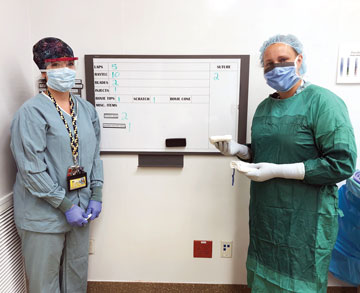Tara Cohen, PhD, CHSE, director of surgical safety and human factors research at Cedars-Sinai Medical Center in Los Angeles, says many facilities might find success in preventing communication breakdowns by minimizing the use of verbal cues
and instead using count boards or sponge holders, which add a visual element to the manual count.
Jillian Bowers, BSN, RN, CNOR, educational nurse coordinator at University of Michigan Health in Ann Arbor, says incorporating customized count boards into her team’s sponge tracking protocol helped them make a “huge improvement”
in the accuracy of the counts. Previously, says Ms. Bowers, surgical teams at her hospital would use various tools and methods to aid their counts, from worksheets that were not visible to the entire team to generic white boards that were
set up differently depending on the team using them. To help standardize the counting method across the hospital and make the count visual — an AORN recommendation — a multidisciplinary team worked together to design the perfect
count board template that every surgical team could use.
“We asked staff members to huddle in small groups and describe their ideal board,” says Ms. Bowers. “From those sessions, we took pieces we liked from each group, shared them with the entire surgical staff and incorporated
feedback from the larger group in the final design.”
The custom board they came up with uses individual magnets that note the full name of surgical items, so they’re easily identifiable. The old whiteboards and count sheets used by the Michigan Health staff included abbreviations and names
that varied depending on the team using them, an inconsistency that increased the potential for error.
Common items used during surgery such as sponges, sharps and miscellaneous supplies are listed down the left side of the board. The number and types of sutures are listed down the right side, so staff can more easily add the numbers vertically.
The use of magnets allows staff to customize the board for each procedure, so that only the items in the surgical field are listed on the board. This helps to reduce the overall clutter of the board, allowing staff to focus on tracking
only the items that are used during surgery and streamlining the counting process.
The custom count board is hung in each OR, adjacent to the sterile field, where it’s clearly visible to all members of the surgical team. It standardizes how counts are done across the facility and makes it easier for the team to quickly
see what items have been counted, and what items are potentially missing. Plus, the sense of ownership staff felt in knowing they helped to develop the counting system meant that adoption of the boards went smoothly. In fact, Ms. Bowers
says the custom boards were added to three surgery centers within the Michigan Health system, creating a standardized and straightforward way to keep track of objects used during surgery and make sure they’re accounted for before
procedures end.
“Allowing the staff the participate in the design of the board gave them ownership of what it looks like, how it works and where it’s placed,” says Ms. Bowers. “We had the staff involved throughout the entire process,
and that’s made a big difference in how well they’ve incorporated it in their routines.”
.svg?sfvrsn=be606e78_3)

.svg?sfvrsn=56b2f850_5)